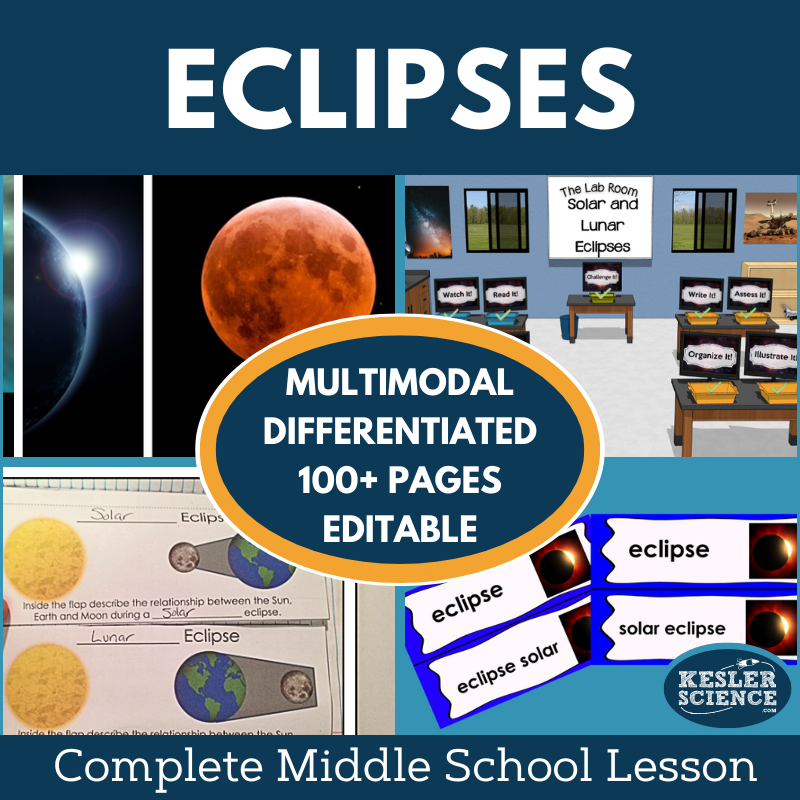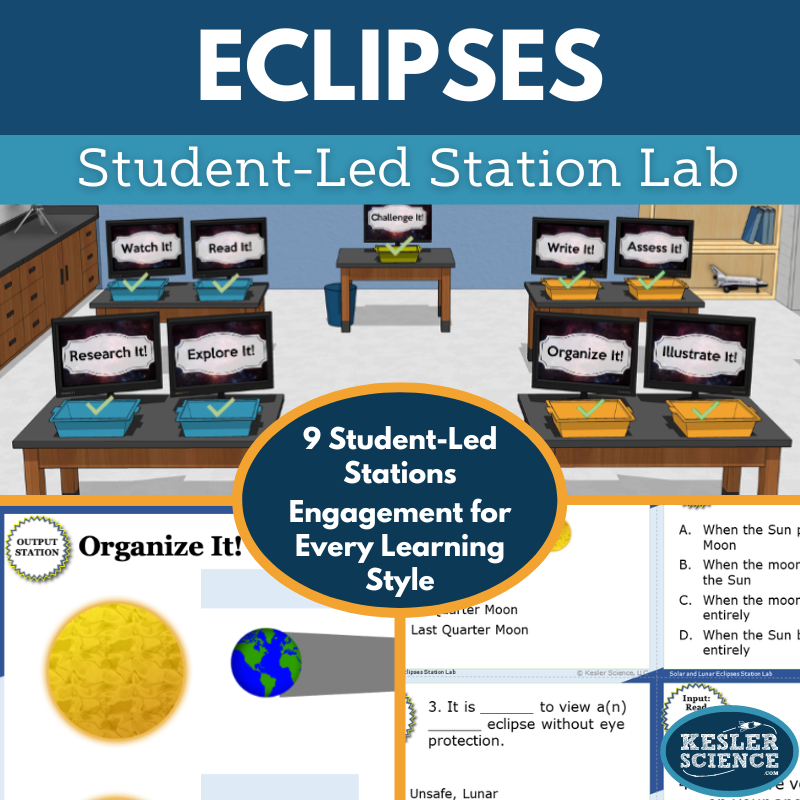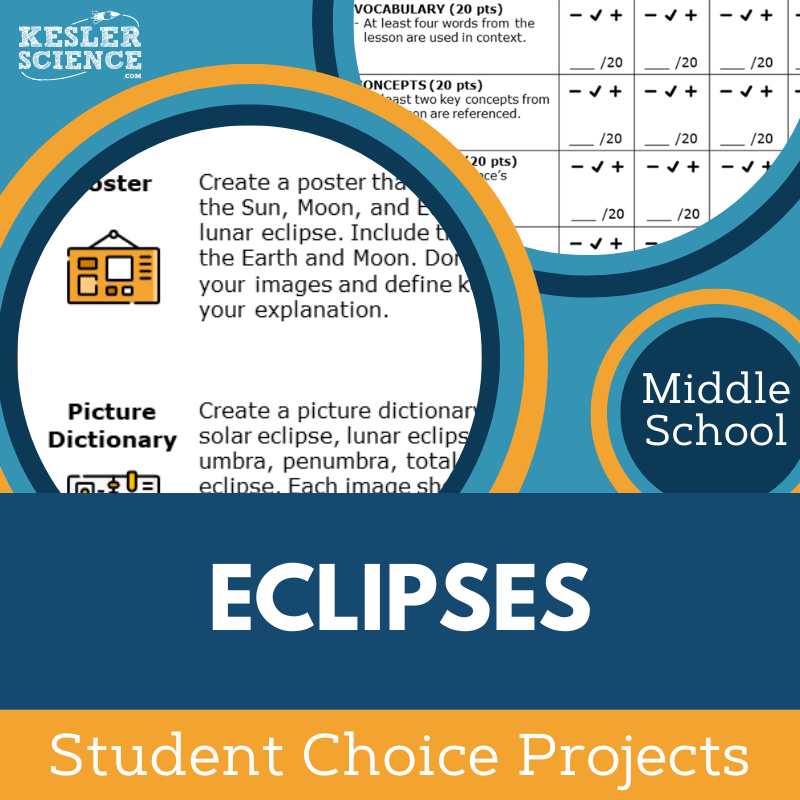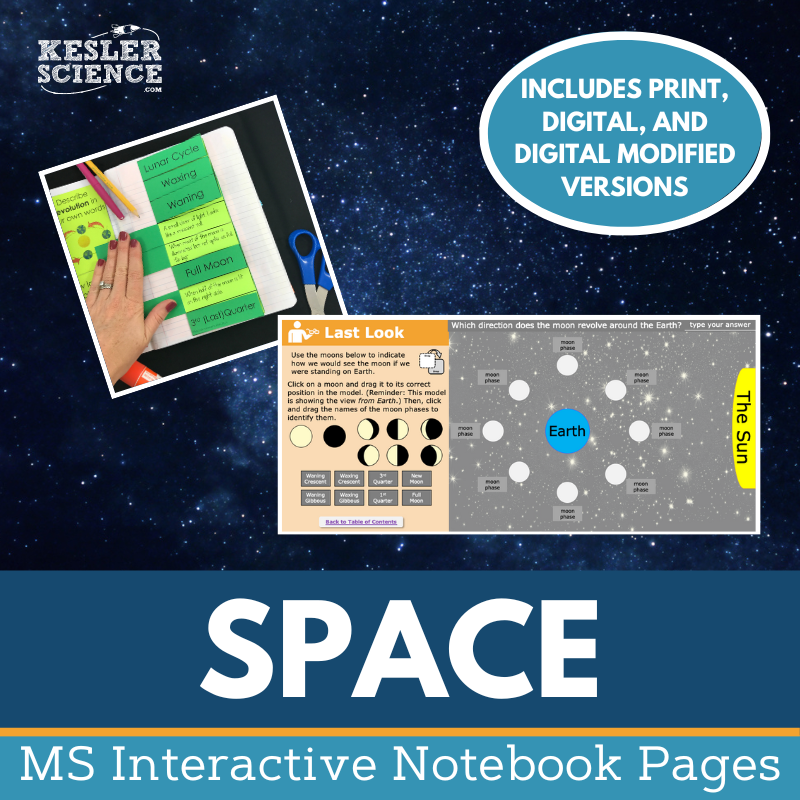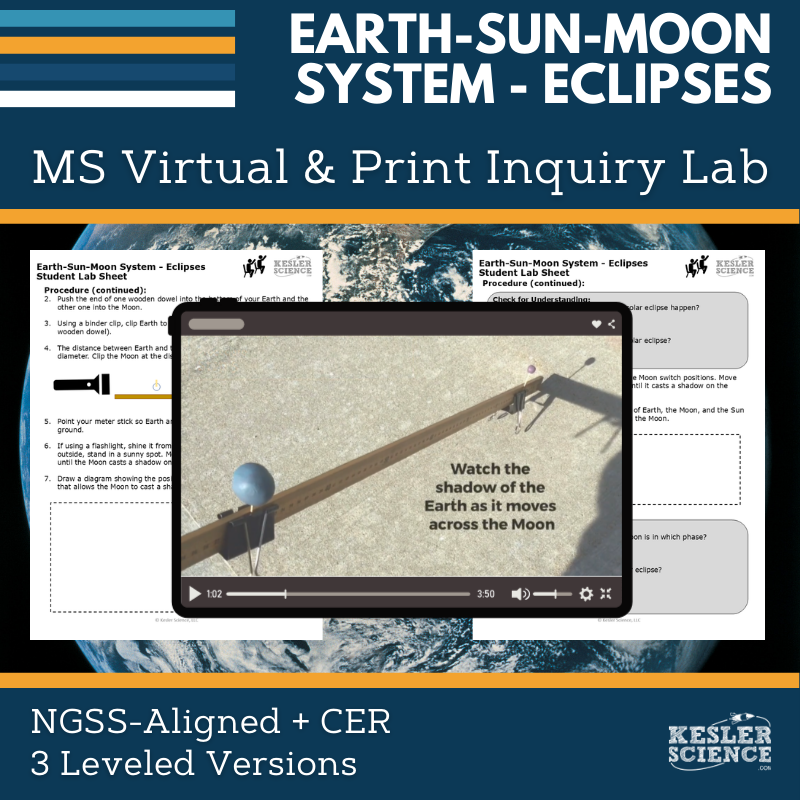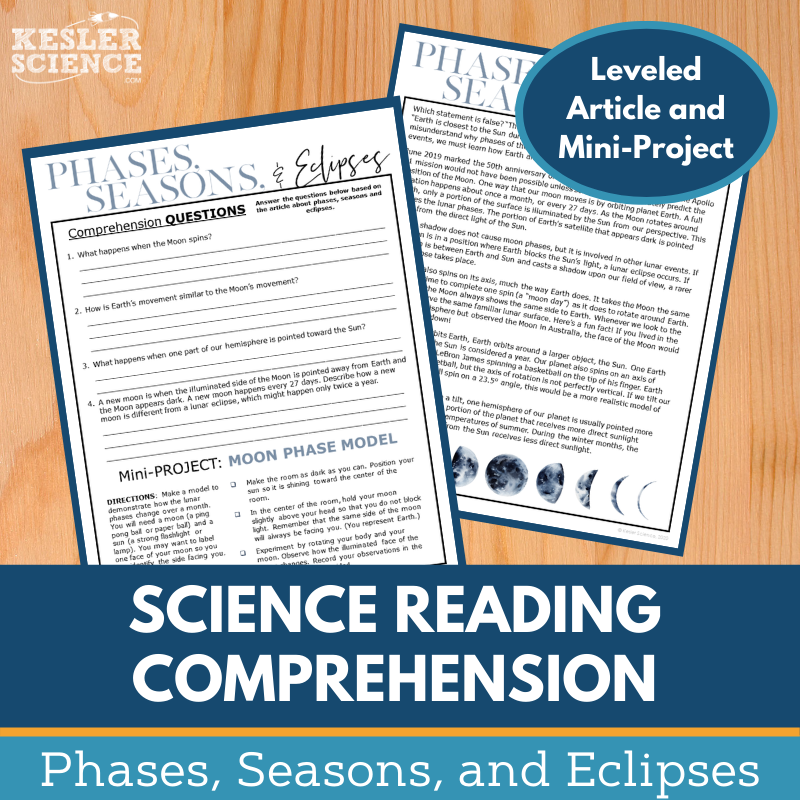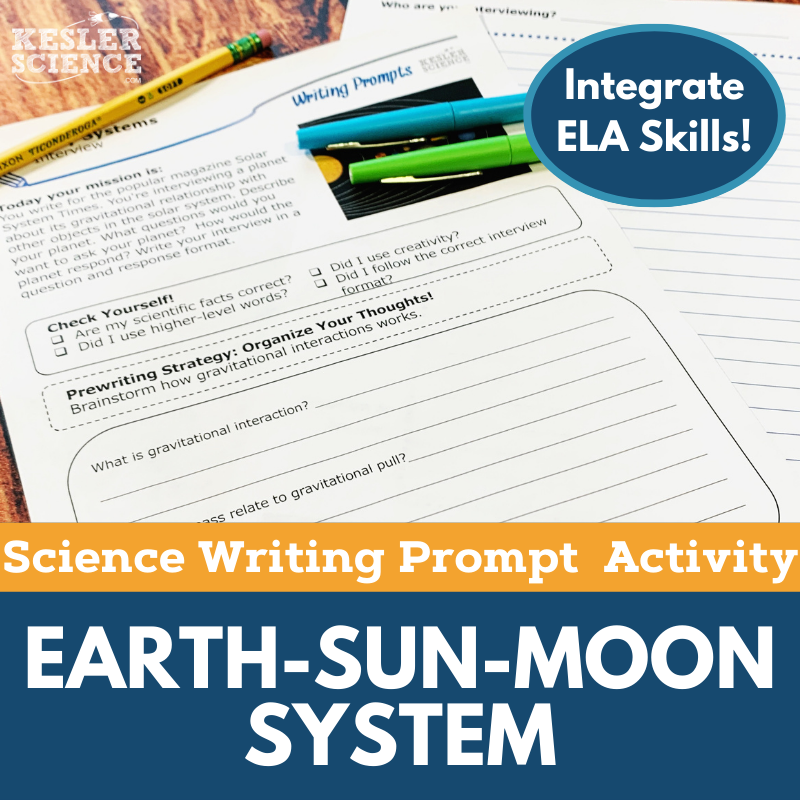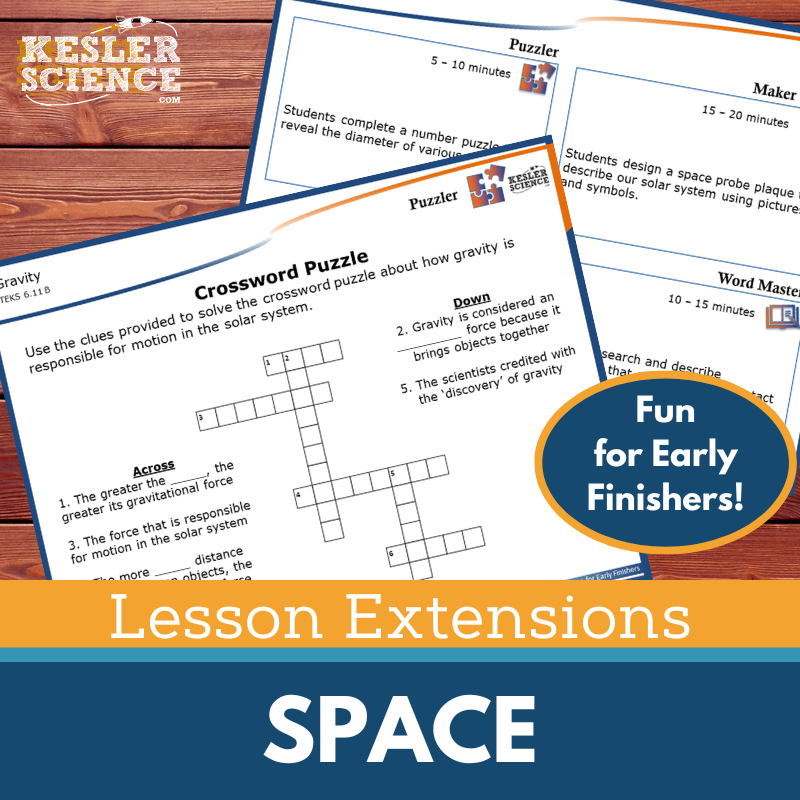Eclipses Activities for Middle School Science
The Kesler Science Eclipses 5E Lesson is a fully editable, low-prep unit that helps middle school students understand how the positions of the Sun, the Moon, and Earth create solar and lunar eclipses. The resources below will give students a comprehensive understanding of eclipses. All of the following materials are also included in the Kesler Science Membership.
The Kesler Science Eclipses 5E Lesson is a fully editable, low-prep unit designed to guide middle school students through the concepts of solar and lunar eclipses. Students explore how the positions of the Sun, the Moon, and Earth create different types of eclipses and use models to understand the shadows that result in partial and total eclipses. The lesson includes presentations, worksheets, assessments, and student-choice projects, all aligned with the 2021 TEKS and designed for differentiated, student-led learning.
Following the 5E Model, the unit begins with engaging objectives, vocabulary word wall cards, and class activities. In the exploration phase, a nine-station, student-led lab offers multimodal learning with hands-on demos, videos, reading passages (in English and Spanish), and interactive digital tasks. Output stations let students show their understanding through writing, drawing, sorting, and formal assessment. A bonus challenge station is included for enrichment.
For explanation, students use editable PowerPoints and interactive notebook pages in English and Spanish, along with note-taking templates. Elaboration is supported through student-choice projects, and evaluation includes STAAR 2.0-aligned assessments in multiple formats. All materials are flexible for use in both classroom and virtual settings.
The Kesler Science Eclipses 5E Lesson is a fully editable, low-prep unit designed to guide middle school students through the concepts of solar and lunar eclipses. Students explore how the positions of the Sun, Moon, and Earth create different types of eclipses and use models to understand the shadows that result in partial and total eclipses. The lesson includes presentations, worksheets, assessments, and student-choice projects, all aligned with the 2021 TEKS and designed for differentiated, student-led learning.
Following the 5E Model, the unit begins with engaging objectives, vocabulary word wall cards, and class activities. In the exploration phase, a nine-station, student-led lab offers multimodal learning with hands-on demos, videos, reading passages (in English and Spanish), and interactive digital tasks. Output stations let students show their understanding through writing, drawing, sorting, and formal assessment. A bonus challenge station is included for enrichment.
For explanation, students use editable PowerPoints and interactive notebook pages in English and Spanish, along with note-taking templates. Elaboration is supported through student-choice projects, and evaluation includes STAAR 2.0-aligned assessments in multiple formats. All materials are flexible for use in both classroom and virtual settings.
The Kesler Science Eclipses Station Lab is a modular, student-led activity designed to engage middle school students while they explore the Earth-Sun-Moon system and the cyclic patterns of eclipses. This resource includes eight differentiated stations, along with a challenge station for early finishers, allowing students to personalize their learning experience. The teacher's role is to facilitate the learning process, providing students with opportunities to direct their own exploration.
The station labs cover various learning styles with input and output activities. Students can engage with hands-on demos "Explore It!", research online "Research It!", read and analyze passages "Read It!", or watch videos "Watch It!". The output stations give students multiple ways to demonstrate their knowledge, such as organizing information "Organize It!", illustrating concepts "Illustrate It!", and writing about their understanding "Write It!".
This activity is ideal for both in-person and virtual learning environments. Each station includes resources such as task cards, signage, and literature, ensuring students can work independently or in small groups. The stations are designed to be adaptable, making them suitable for a wide range of learners and classroom settings.
The Kesler Science Eclipses Station Lab is a modular, student-led activity designed to engage middle school students while they explore the Earth-Sun-Moon system and the cyclic patterns of eclipses. This resource includes eight differentiated stations, along with a challenge station for early finishers, allowing students to personalize their learning experience. The teacher's role is to facilitate the learning process, providing students with opportunities to direct their own exploration.
The station labs cover various learning styles with input and output activities. Students can engage with hands-on demos "Explore It!", research online "Research It!", read and analyze passages "Read It!", or watch videos "Watch It!". The output stations give students multiple ways to demonstrate their knowledge, such as organizing information "Organize It!", illustrating concepts "Illustrate It!", and writing about their understanding "Write It!".
This activity is ideal for both in-person and virtual learning environments. Each station includes resources such as task cards, signage, and literature, ensuring students can work independently or in small groups. The stations are designed to be adaptable, making them suitable for a wide range of learners and classroom settings.
The Kesler Science Eclipses Student Choice Projects allow middle school students to choose a project that suits their learning style, offering flexibility and creativity in demonstrating their understanding. The resource includes six project options, plus a "design your own" project, with a grading rubric for assessment by teachers, peers, or self-reflection.
Teachers can easily modify the rubric to fit their grading needs, and the projects are differentiated for students with varying abilities. With nine options to choose from, students can explore the topic in diverse ways, and the materials support a variety of learning styles, making this project suitable for all learners.
Included in the package are editable project pages and teacher directions to guide students and provide support. The projects use common classroom supplies, and many can be done digitally, allowing for seamless integration into both in-person and virtual classrooms.
The Kesler Science Eclipses Student Choice Projects allow middle school students to choose a project that suits their learning style, offering flexibility and creativity in demonstrating their understanding. The resource includes six project options, plus a "design your own" project, with a grading rubric for assessment by teachers, peers, or self-reflection.
Teachers can easily modify the rubric to fit their grading needs, and the projects are differentiated for students with varying abilities. With nine options to choose from, students can explore the topic in diverse ways, and the materials support a variety of learning styles, making this project suitable for all learners.
Included in the package are editable project pages and teacher directions to guide students and provide support. The projects use common classroom supplies, and many can be done digitally, allowing for seamless integration into both in-person and virtual classrooms.
The Kesler Science Space Science Interactive Notebook is an engaging resource for teachers looking to create interactive learning experiences for their students. It includes both print and digital versions, making it perfect for traditional classrooms, 1:1 environments, or distance learning.
The bundle covers key Space Science topics such as asteroids, meteors, and comets, the Big Bang theory, eclipses, the electromagnetic spectrum, galaxies, and more. The digital version features a PowerPoint interactive notebook, which can be uploaded to Google Slides or learning management systems like MS Teams or Canvas. Reflection pages and space for students to take notes are included, along with a teacher answer key and modified versions for students with accommodations.
The print version provides a full set of blank templates for students, pre-filled templates for those needing modifications, and color photos to illustrate how each template should be used. This bundle is designed to support differentiated learning and keep students engaged in key space science concepts.
The Kesler Science Space Science Interactive Notebook is an engaging resource for teachers looking to create interactive learning experiences for their students. It includes both print and digital versions, making it perfect for traditional classrooms, 1:1 environments, or distance learning.
The bundle covers key space science topics such as asteroids, meteors, and comets, the Big Bang theory, eclipses, the electromagnetic spectrum, galaxies, and more. The digital version features a PowerPoint interactive notebook, which can be uploaded to Google Slides or learning management systems like MS Teams or Canvas. Reflection pages and space for students to take notes are included, along with a teacher answer key and modified versions for students with accommodations.
The print version provides a full set of blank templates for students, pre-filled templates for those needing modifications, and color photos to illustrate how each template should be used. This bundle is designed to support differentiated learning and keep students engaged in key space science concepts.
The Eclipses Inquiry Lab aligns with NGSS MS-ESS1-1 and helps students develop a model of the Earth-Sun-Moon system to explain how solar and lunar eclipses occur. This lab offers both a hands-on printed version and a fully digital, interactive experience, which includes a pre-recorded video demonstration. Each format comes with comprehension questions, Claim-Evidence-Reasoning (C.E.R.) prompts, and reflection sections to guide student learning.
Students will use materials like dowels, clay, and a flashlight to build a model that shows how light from the Sun is blocked by either the Moon or Earth, resulting in eclipses. For classrooms without materials or students participating remotely, the digital lab allows students to follow along virtually and engage with the concepts through interactive elements embedded in the file.
To support all learners, the lab includes three differentiated levels: a guided Dependent version, a structured Modified version, and a student-led Independent version. Teachers can easily adapt the content using editable files compatible with Google Slides, and all materials include teacher resource pages and answer keys to simplify instruction and grading.
The Eclipses Inquiry Lab aligns with NGSS MS-ESS1-1 and helps students develop a model of the Earth-Sun-Moon system to explain how solar and lunar eclipses occur. This lab offers both a hands-on printed version and a fully digital, interactive experience, which includes a pre-recorded video demonstration. Each format comes with comprehension questions, Claim-Evidence-Reasoning (C.E.R.) prompts, and reflection sections to guide student learning.
Students will use materials like dowels, clay, and a flashlight to build a model that shows how light from the Sun is blocked by either the Moon or Earth, resulting in eclipses. For classrooms without materials or students participating remotely, the digital lab allows students to follow along virtually and engage with the concepts through interactive elements embedded in the file.
To support all learners, the lab includes three differentiated levels: a guided Dependent version, a structured Modified version, and a student-led Independent version. Teachers can easily adapt the content using editable files compatible with Google Slides, and all materials include teacher resource pages and answer keys to simplify instruction and grading.
The engaging lesson on phases, seasons, and eclipses includes a nonfiction article about how Earth and the Moon move in relation to the Sun. Students complete comprehension questions and a hands-on moon phase model to reinforce their learning. Designed for middle schoolers, the reading passage increases science literacy while fostering critical thinking through textual analysis and model creation.
The resource includes leveled articles (Lexile 1100-1300), comprehension questions, and an interactive mini-project. With colorful graphics, Cornell notes templates, and printable or digital options, it’s ideal for a variety of classroom needs. Whether used for absent students, sub plans, or extra credit, this activity supports science literacy and sparks meaningful discussions.
Perfect for in-person or virtual learning, the resource integrates seamlessly with platforms like Google Classroom or Schoology. Students can work directly in digital files or with printed handouts, making it a versatile tool for whole-class instruction, differentiation, or independent study.
The engaging lesson on phases, seasons, and eclipses includes a nonfiction article about how Earth and the Moon move in relation to the Sun. Students complete comprehension questions and a hands-on moon phase model to reinforce their learning. Designed for middle schoolers, the reading passage increases science literacy while fostering critical thinking through textual analysis and model creation.
The resource includes leveled articles (Lexile 1100-1300), comprehension questions, and an interactive mini-project. With colorful graphics, Cornell notes templates, and printable or digital options, it’s ideal for a variety of classroom needs. Whether used for absent students, sub plans, or extra credit, this activity supports science literacy and sparks meaningful discussions.
Perfect for in-person or virtual learning, the resource integrates seamlessly with platforms like Google Classroom or Schoology. Students can work directly in digital files or with printed handouts, making it a versatile tool for whole-class instruction, differentiation, or independent study.
The Kesler Science Earth-Sun-Moon System Science Writing Prompt Activity uses a creative letter-writing format to help middle school students deepen their understanding of earth science concepts like lunar phases, eclipses, and seasons. Designed to align with NGSS MS ESS1-1, this engaging resource encourages science reasoning and exploration while enriching students' writing skills. Perfect for virtual or in-class use, the activity keeps students engaged and fosters cross-curricular connections.
This low-prep, high-quality resource includes teacher directions, answer guides, full and half-sheet handouts, and a digital version compatible with platforms like Google Slides. Students can follow structured pre-writing strategies and self-check steps, creating polished and thoughtful responses. These materials work seamlessly with Kesler’s other products, making it a versatile addition to any earth science unit.
Ideal for elaboration, review, or differentiation, this activity suits a variety of classroom needs, from pre-assessments and extra credit to TELPAS samples or make-up work. Teachers can display final products as bulletin board pieces or incorporate them into student writing portfolios for an impactful and memorable learning experience.
The Kesler Science Earth-Sun-Moon System Science Writing Prompt Activity uses a creative letter-writing format to help middle school students deepen their understanding of earth science concepts like lunar phases, eclipses, and seasons. Designed to align with NGSS MS ESS1-1, this engaging resource encourages science reasoning and exploration while enriching students' writing skills. Perfect for virtual or in-class use, the activity keeps students engaged and fosters cross-curricular connections.
This low-prep, high-quality resource includes teacher directions, answer guides, full and half-sheet handouts, and a digital version compatible with platforms like Google Slides. Students can follow structured pre-writing strategies and self-check steps, creating polished and thoughtful responses. These materials work seamlessly with Kesler’s other products, making it a versatile addition to any earth science unit.
Ideal for elaboration, review, or differentiation, this activity suits a variety of classroom needs, from pre-assessments and extra credit to TELPAS samples or make-up work. Teachers can display final products as bulletin board pieces or incorporate them into student writing portfolios for an impactful and memorable learning experience.
The Kesler Science Space Lesson Extensions provide engaging activities designed to challenge fast finishers and deepen student learning. These critical thinking tasks are connected to NGSS and TEKS space standards, offering rigorous but fun opportunities to explore topics in greater depth. With activities like puzzles, hands-on maker space tasks, tech connections, and creative word writing, these extensions promote STEAM skills and digital literacy.
The Lesson Extensions are structured to provide flexible support for teachers, with clear directions, answer keys, and both digital and paper versions. These materials help reinforce the lesson’s core concepts while offering ways to engage students during testing or other gaps in the schedule.
Perfect for independent learners, these activities push students to apply their knowledge creatively while connecting it to real-world applications. The extensions cover a variety of space science topics, including gravity, space travel, and the lunar cycle, providing additional challenges that extend the learning experience beyond the standard lesson.
The Kesler Science Space Lesson Extensions provide engaging activities designed to challenge fast finishers and deepen student learning. These critical thinking tasks are connected to NGSS and TEKS space standards, offering rigorous but fun opportunities to explore topics in greater depth. With activities like puzzles, hands-on maker space tasks, tech connections, and creative word writing, these extensions promote STEAM skills and digital literacy.
The Lesson Extensions are structured to provide flexible support for teachers, with clear directions, answer keys, and both digital and paper versions. These materials help reinforce the lesson’s core concepts while offering ways to engage students during testing or other gaps in the schedule.
Perfect for independent learners, these activities push students to apply their knowledge creatively while connecting it to real-world applications. The extensions cover a variety of space science topics, including gravity, space travel, and the lunar cycle, providing additional challenges that extend the learning experience beyond the standard lesson.
Year-Round Resources
These year-round activities will increase your students' understanding of many middle school science topics. All of these activities are also included in the Kesler Science Membership.
Visual Data & Graphing
You're not alone if your students struggle with understanding graphs, charts, and tables. It's a skill that takes an enormous amount of practice. This resource will help students build a strong foundation in analyzing data and creating their own data visualizations.
Bell Ringers and Warm-Ups
These middle school science bell ringers are an excellent way to engage your students as soon as they walk into your classroom. This comprehensive FULL YEAR resource includes everything you need to start off each science class with an interesting warm-up activity.
Review Board Games
Each game board has been carefully designed to keep students engaged. There are 10 different action spaces on each board and dozens of question cards. All of the actions are related to science concepts and keep the students motivated throughout the game.
Each game is ready to play. Simply print out the board and the cards and let the students enjoy reviewing nine different units.
Essential Questions
Below are the essential questions associated with the lessons and activities included in this unit. This topic is only one of more than 100 middle school science topics included in the Kesler Science Membership.
-
Can you describe how the positions of the Sun, Moon and Earth determine the type of eclipse?
-
Can you model how the shadow cast in an eclipse causes partial and total eclipses?
Kesler Science Membership
Imagine never having to search for another middle school science lesson again. The membership gives you access to ALL of the Kesler Science products in one place (Yes, including everything above).
Say goodbye to long hours of lesson prep.

